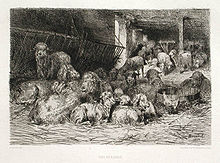

Albert Heinrich Brendel (born in 1827, Berlin, Germany) was a painter most famous for his depictions of animals in a rural setting. He studied in the Prussian Academy of Arts under Wilhelm Krause. In 1851 he went to Paris, and studied under Couture and Palizzi; thence to Italy, and home to Berlin in 1853, completing his studies under Carl Steffeck. For the next ten years he lived mainly in Paris, and worked in the summer months at Barbizon school, in the forest of Fontainebleau, which was also the scene of the labours of Jean-François Millet, Théodore Rousseau, Narcisse Virgilio Díaz, Constant Troyon, and other artists; and he continued, till 1869, to visit Barbison in the summer, after he moved in 1865 to Berlin for the winter. In 1868 he was made a member of the Berlin Academy, and in 1875 became professor at the Weimar Saxon-Grand Ducal Art School. His first works were sea-pieces, but afterwards he devoted himself to animal painting (more especially horses and sheep), in which he was very successful. He received medals at various exhibitions at Paris, Berlin, Munich, Vienna, and Nantes. He died in 1895.
- Berlin. Gallery. Return to the Village.
- Paris. Luxembourg. Sheepfold at Barbison (exhibited at the Salon in 1863).
See also
References
External links
 This article incorporates text from a publication now in the public domain: Bryan, Michael (1886). "Brendel, Heinrich Albert". In Graves, Robert Edmund (ed.). Bryan's Dictionary of Painters and Engravers (A–K). Vol. I (3rd ed.). London: George Bell & Sons.
This article incorporates text from a publication now in the public domain: Bryan, Michael (1886). "Brendel, Heinrich Albert". In Graves, Robert Edmund (ed.). Bryan's Dictionary of Painters and Engravers (A–K). Vol. I (3rd ed.). London: George Bell & Sons.
This article about a German painter is a stub. You can help Misplaced Pages by expanding it. |